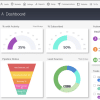Source: Deseret News —
Britta Joslyn was at a breaking point. She’d decided to move out of her house in Heber City, Utah, after a split-up. But, finding a new home proved Sisyphean. She needed to find a rental close to her children’s school that would accommodate her eight-year-old twins and her service dog, but everything was out of her price range. Landlords were asking her to prove she made triple the cost of the rent. She couldn’t. Joslyn is a speech pathologist, a professional that makes $83,000 a year on average. She shouldn’t be in this situation. Right?
Joslyn’s not alone in her struggle. Nearly half of Americans say housing affordability in their community is a major problem, according to Pew Research Center. Across the country, home prices are now out of reach for median wage earners in 97 percent of counties. This is a significant increase from 2021, when 69 percent of U.S. counties were categorized as historically less affordable, according to the Home Affordability Report from ATTOM, a real estate data firm.
In almost every community you consider, the housing situation is bad. Very bad. According to Moody’s home price index, home prices nationally have increased 32 percent over the past two years. The National Association of Realtors reports an even bigger jump of 39 percent. During Salt Lake City’s first phase of the Thriving in Place initiative, which was introduced in July by the Department of Community and Neighborhoods and aims to find solutions to housing displacement, nearly half of respondents knew someone who has already moved due to eviction or high housing costs. Almost 20 percent say they have had to move due to rent increases, while 13 percent are on the verge of moving due to increased costs. Close to 40 percent of respondents want to buy but cannot afford a home.
While rent usually increases 3 to 4 percent annually, it’s jumped a stunning 17 percent this year, and 79 percent over the past five years. Even in the face of the cooling housing market, demand is high and supply is low. A short supply of single family homes stymies homebuyers as out-of-state buyers, foreign investors and developers snatch up property. Tenants who lease can no longer afford increasing rents, and, priced out of entering the homeowning market, are left with little to no options for housing, especially because the entire Wasatch Front has become increasingly expensive. According to reports from the National Low Income Housing Coalition, extremely low-income renters in the U.S. face a shortage of approximately seven million homes.
Jasmine Walton, a marketing director at a housing nonprofit called NeighborWorks Salt Lake, spent a year trying to find a house on the west side of Salt Lake City where she grew up. She and her fiancé were beat out by cash offers from out-of-state investors. She says they were able to finally close on a house because of a down payment assistance grant, closing cost grant and an 80/20 loan — public programs that operate on local, state and federal levels that she says she might not have known about if she didn’t work in the housing industry.
“It’s a market unlike any other we’ve had, at least in my experience, and I’ve been working on it for almost 50 years,” says James Wood, the Ivory-Boyer Senior Fellow at The University of Utah’s David Eccles School of Business Policy Institute. “For homeowners, we’ve pretty much priced out the next generation. Even if you’re a household with two moderate incomes, it will be a stretch.”
The Thriving in Place study found that a quarter of the city’s population is spending more than half their monthly income on housing. “It’s very hard for (people) to live anywhere along the Wasatch Front,” says Susan Lundmark, a project manager in the city’s department of community and neighborhoods, who worked on the study. “People are doubling up, living in basements, living in cars. Or it’s possible that they’re leaving the region altogether.”
Currently, a quarter of local renters are considered “severely rent burdened,” which means that they’re spending more than half their income on housing. That statistic extends across the region. And the nation.
A study from the Federal Home Loan Mortgage Corporation, or Freddie Mac, found that there’s a deficit of 3.8 million homes in the U.S. — a number that’s nearly doubled in the last decade, and that tracks across 47 states. Research from Freddie Mac found that the overall housing deficit increased 52 percent from 2018 to 2020, in large part because of a lack of single-family starter homes.
Across the country, that’s impacting those who are essential to our communities: educators like Joslyn, and service workers like Walton, who says that she has cousins in the Midwest who are facing the same thing. A recent study from the Keystone Policy Center, a Colorado-based nonprofit, found that fewer than one-fifth of homes across Colorado are affordable to teachers who make an average salary in their district. In Denver, teachers making the school district average of $64,000 could only afford 14 percent of the homes in the area.
Home ownership — and even simply having a roof over your head — is out of reach for more Americans now than it has been in generations. The housing market is broken, and it’s becoming increasingly hard for people in the middle of the economic pack, thanks to a complicated cocktail of supply shortages, investment developers, wage flatness, Covid-19 mobility and the weird, uneven edge of what can feel like a recession. There are tax credits and housing vouchers for low-income residents — although those are largely insufficient, too — and high-income people can ride the waves because they have more flexibility or generational wealth, but it’s squeezing the middle class.
This is a national problem, and it won’t be easy to fix. But Utah may be experimenting with one solution that could be an example to the rest of the country.














